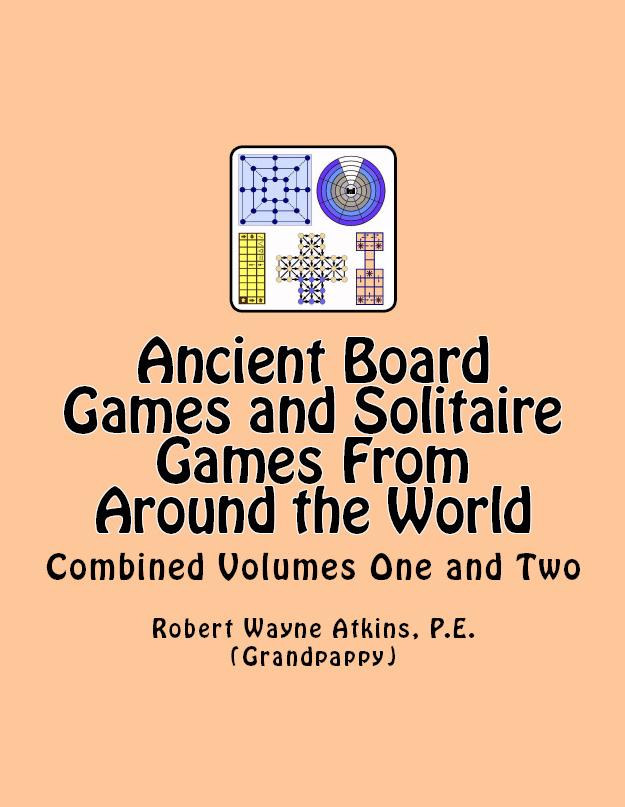






































| Game Pieces | 1 |
| Four Sided Die and Four Throw Sticks | 2 |
| Game Rules, and Which Player Gets Each Color, and Which Player Goes First | 3 |
| Achi (Africa), and Picaria (Pueblo Indians, United States before 1600 A.D.) | 4 |
| Horseshoe (China) | 5 |
| Pong hau k'l (China) | 6 |
| Ovid's Game (Before 8 A.D. when Jesus was a boy) | 7 |
| Tac Tix (Denmark in the 1940s) | 8 |
| Fox and Geese (Iceland before 1300 A.D.) | 10 |
| Teeko (John Scarne in 1937 and revised in 1952) | 12 |
| Four Field Kono (Korea) | 13 |
| Five Field Kono (Korea) | 14 |
| Hunting Animals (North American Indians) | 15 |
| Seega (Egypt before 1324 B.C.) | 16 |
| Derrah (Nigeria, Africa) | 19 |
| El-Quirkat (Arabia before 1400 B.C.) or Alquerque (Spain) | 18 |
| The Royal Game of Ur (Sumeria, Mesopotamia around 2,500 B.C.) | 22 |
| Senet (Thirty Squares) (Egypt around 2,650 B.C.) | 24 |
| Palm Tree Game (Hounds and Jackals) (Thebes, Egypt around 2,000 B.C.) | 26 |
| Chinese Checkers (Boston, Massachusetts in 1883 or 1884) | 28 |
| Checkers or Draughts (France around 1100 A.D.) | 30 |
| Turkish Checkers (Turkey) | 30 |
| Diagonal Checkers and Pyramid Checkers | 32 |
| Checker Solitaire and Diamond Chinese Checkers | 33 |
| Triangular Checkers and The Fox and the Hounds | 34 |
| German, Russian, Italian, and Thai Checkers | 35 |
| Polish, Continental, or International Checkers (Paris, France around 1727) | 36 |
| Nine Men's Morris (Egypt before 1400 B.C.) | 38 |
| Mu Torere (New Zealand) | 40 |
| Serpents and Stone Warriors (North American Indians) | 42 |
| Sixteen Soldiers (India) | 44 |
| Asalto or Assault (Soldiers and Patriots) (Germany, Spain, France, England, Sweden) | 46 |
| The Queen's Guard | 48 |
| Ringo (Castle Siege) (Germany in the late 1800s) | 50 |
| Chasing the Girls (Iceland before 200 A.D.) | 52 |
| Tourne-Case (France in the 1600s) | 54 |
| Tabula (Rome, Italy before 100 A.D.) | 56 |
| Gomoku (Japan between 794 to 1185 A.D.) | 58 |
| Dai Hasami Shogi (Japan) | 60 |
| Petteia (Greece before 360 B.C.) | 62 |
| Latrunculi (Rome before 27 B.C.) | 64 |
| Evasion (Robert Wayne Atkins USA 2019 ) | 66 |
| Tablut (Lapland, Finland before 1732) | 68 |
| Hnefatafl, The Viking Game (Scandinavia before 400 A.D.) | 70 |
| Go (Japan) or Bakuk (Korea) or Wei Ch'i (China before 2258 B.C.) | 73 |
| Pyramid Solitaire | 79 |
| Square Solitaire, and Nine Men Solitaire (United States in early 1900s) | 80 |
| Hexagon Solitaire | 81 |
| Six Men Solitaire (early 1900s), and Eight Men Solitaire, and Sixteen Men Solitaire (England 1800s) | 82 |
| Square Four Corner Solitaire (1800s), and Eight Point Star Solitaire | 83 |
| Thirteen Position Solitaire | 84 |
| Six by Six Square Solitaire | 85 |
| French Solitaire (France in 1600s), and Poindexter | 86 |
| English Solitaire, and Diamond Solitaire | 88 |
| Continental Solitaire | 90 |
| Solutions to Some of the Solitaire Games | 92 |
| Index | 94 |
| About the Author | 96 |

